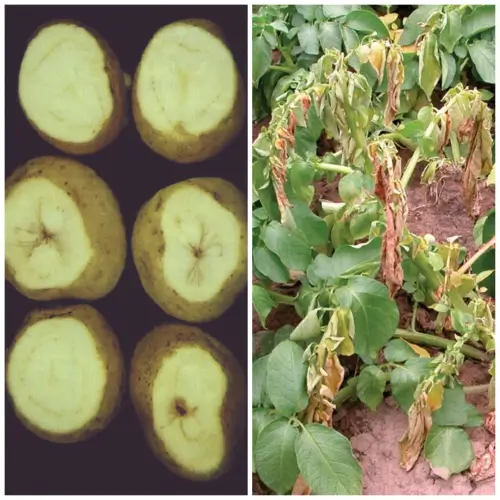Potato Verticillium Wilt: Identification, Impact, and Management Strategies
Publish Date: 2024-12-29
Verticillium wilt is a chronic disease in potatoes caused by soil-borne fungi. Though not as aggressive as late blight or early blight, it poses a significant challenge to potato growers due to its ability to persist in the soil for extended periods. This article discusses the causes, symptoms, and management strategies for combating Verticillium wilt in potato crops.

What is Verticillium Wilt?
Verticillium wilt is a vascular disease caused by fungi in the Verticillium genus, most commonly Verticillium dahliae and Verticillium albo-atrum. The fungi invade the plant’s vascular system, disrupting water and nutrient transport, leading to stunted growth and reduced yields. The disease is particularly troublesome because it can persist in the soil for years, infecting subsequent crops.
Causes of Verticillium Wilt
Verticillium wilt is primarily caused by fungal pathogens that thrive in the soil. Here are the main factors contributing to its spread:
- Soil Infestation: The fungi produce resilient structures called microsclerotia, which can survive in the soil for 8–10 years without a host plant.
- Infected Seed Tubers: Planting infected or contaminated seed tubers introduces the pathogen into the field.
- Susceptible Varieties: Certain potato cultivars are more vulnerable to infection than others.
- Environmental Conditions: Warm soil temperatures (20–25°C) and dry conditions favor the development of symptoms.
Symptoms of Verticillium Wilt
The symptoms of Verticillium wilt often resemble those of water stress or nutrient deficiencies, making diagnosis challenging. They typically appear later in the growing season, during periods of high plant stress.
Foliage Symptoms
- Yellowing of Leaves: Lower leaves turn yellow, progressing upward.
- Wilted Appearance: Affected leaves become limp and wilt, especially during hot or dry conditions.
- V-shaped Lesions: Leaves may develop V-shaped lesions extending from the margins inward.
- Premature Defoliation: Severe infections lead to early leaf drop, weakening the plant.
Stem and Vascular Symptoms
- Discoloration of Vascular Tissue: Cutting through infected stems reveals brown or black streaks in the vascular tissue.
- Stunted Growth: Plants often exhibit reduced vigor and smaller overall size.
Tuber Symptoms
- Tubers may exhibit reduced size and quality.
- In some cases, brown discoloration of the vascular ring inside the tuber can be observed.
Disease Cycle
The life cycle of Verticillium wilt involves the following stages:
- Overwintering: Microsclerotia survive in the soil, plant debris, or infected tubers.
- Germination: When a suitable host is present, the microsclerotia germinate and produce fungal hyphae.
- Root Infection: The fungi enter the roots and move into the plant’s vascular system, spreading throughout the plant.
- Sporulation: New microsclerotia are produced in infected tissues, which return to the soil when the plant dies.
This persistent cycle makes Verticillium wilt a long-term issue for potato growers.
Management Strategies for Verticillium Wilt
Managing Verticillium wilt requires a combination of cultural practices, resistant cultivars, and soil management. Since there are no effective chemical treatments for the disease, prevention is the key to minimizing its impact.
1. Crop Rotation
- Rotate potatoes with non-host crops such as cereals or grasses for at least 3–4 years.
- Avoid planting other solanaceous crops (e.g., tomatoes, peppers, eggplants) in the same field, as they are also susceptible.
2. Use of Resistant Varieties
- Choose potato varieties with partial resistance to Verticillium wilt.
- While resistance is not complete, these varieties can reduce disease severity.
3. Sanitation Practices
- Use certified, disease-free seed tubers to prevent introducing the pathogen into clean fields.
- Remove and destroy infected plant debris after harvest to reduce inoculum levels.
4. Soil Management
- Improve soil health by adding organic matter and maintaining balanced nutrient levels, particularly potassium.
- Avoid soil compaction and water stress, as these factors exacerbate disease symptoms.
5. Biological Control
- Some biocontrol agents, such as Trichoderma species, can suppress Verticillium populations in the soil.
- These agents work by competing with the pathogen or inducing plant resistance.
6. Irrigation Management
- Avoid over-irrigating, as excessive moisture can promote disease development.
- Drip irrigation is preferred to minimize wet conditions around the plant base.
Economic and Environmental Impact
Verticillium wilt is a chronic problem that reduces potato yields over time. Fields with high levels of inoculum may become unsuitable for potato production unless properly managed. Moreover, the disease limits farmers’ crop rotation options, adding to its economic burden. Environmentally, reliance on soil fumigants or chemical controls (where applicable) can have long-term negative effects, making sustainable practices critical.
Conclusion
Verticillium wilt in potatoes is a challenging disease due to its persistence and lack of direct treatment options. However, by adopting integrated management practices such as crop rotation, resistant varieties, and improved soil health, growers can significantly reduce its impact. Early diagnosis and consistent efforts to maintain field hygiene are essential for long-term disease control.
References:
This article is based on general agricultural knowledge and original research. Always consult local agricultural extension services for region-specific guidance.